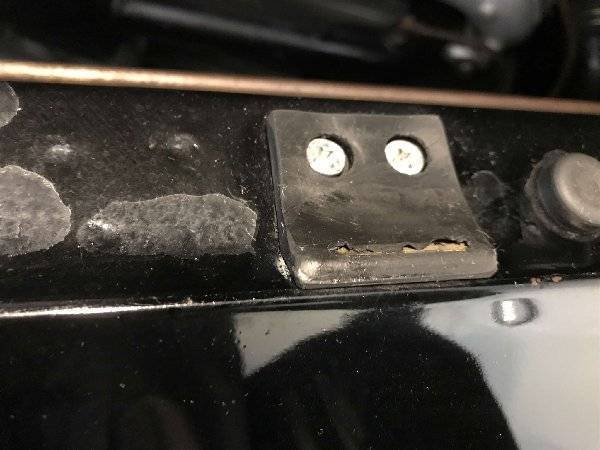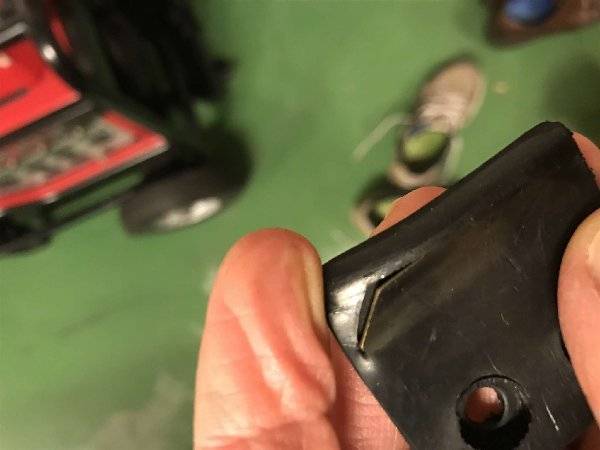|
Re: clock rebuild
|
||||
|---|---|---|---|---|
|
Just can't stay away

|
I used David Lindquist athttp://magicdave.com/autoclock/home.htm
for my repair on 1949 model 2365. They did a great job and did not overcharge
Posted on: 2017/12/21 21:49
|
|||
|
||||
|
Re: 23rd series rubber hood fender bumpers
|
||||
|---|---|---|---|---|
|
Just can't stay away

|
Steele said that my springs were too tight. But as you know, there is no way to adjust them.
The proof of the quality problem for me was the failure of the new bumper with light pressure from my finger without even installing the bumper on the car. I am waiting for their response on the new failure of the one that has not been installed on the car.
Posted on: 2017/12/1 10:24
|
|||
|
||||
|
Re: 23rd series rubber hood fender bumpers
|
||||
|---|---|---|---|---|
|
Just can't stay away

|
Here is one that failed on the car
Posted on: 2017/11/30 22:06
|
|||
|
||||
|
23rd series rubber hood fender bumpers
|
||||
|---|---|---|---|---|
|
Just can't stay away

|
I am having a continuing problem with new hood bumpers from Steele Rubber products that are failing. The rubber is so thin that the metal slices through and chips the paint on the side of the hood when the hood is opened. See picture included here. This is a brand new rubber bumper that was not installed on the car yet but the metal is already slicing through the rubber even with gentle pressure from my finger.
I have had three sets of these fail so far and the brand new paint job on the hood is chipping as a result. As a temporary move, I have added black tape on the edge of the hood and vaseline to keep from doing further damage to the hood paint. I thought that maybe the spring clips that hold the hood down while it pivots might be too tight but there is no way to adjust them. Added to this, now I have one that fails right out of the package shown here. If I cannot get Steel Rubber to get me a good set, is there another source of rubber products that I could consider? I would appreciate any inputs.
Posted on: 2017/11/30 22:03
|
|||
|
||||
|
Re: 23 rd series exhaust
|
||||
|---|---|---|---|---|
|
Just can't stay away

|
Dear All,
I used the recommended replacement muffler from Max Merritt on my 49 coupe (model 2365) and it worked out well. They have them built from scratch at a local shop as close to original specifications as possible. The original mufflers on these cars were straight through, meaning that you could visibly look right through down the center of it. This was done so that the right amount of backpressure is applied in the exhaust system. Ernie's suggestion is also a good one and I first tried the fiberglass pack before I ordered the replacement from Max Merritt. The glass pack worked well but was a little louder than what I wanted from the car.
Posted on: 2017/10/2 21:01
|
|||
|
||||
|
Re: Change of radiator core affecting cooling performance in 1949, 23rd series
|
||||
|---|---|---|---|---|
|
Just can't stay away

|
Thank you.
I have not measured the amperage of the 6 volt motor but the supplier (Scott's cooling fans) said that he had it measured and it draws around 10 amps. I would like to confirm that myself soon. I don't have a radio or heater motor in the car as these were options that the original owner did not order with the car (it was a Texas car and I guess they didn't need heat) Is 10 amps too much when the headlights are on? As for the efficiency of the radiator, I would like to do a controlled experiment with the proper radiator with the correct fin count. I hope to be able to do the installation over the winter so that I can test it next summer.
Posted on: 2017/9/18 8:13
|
|||
|
||||
|
Re: Change of radiator core affecting cooling performance in 1949, 23rd series
|
||||
|---|---|---|---|---|
|
Just can't stay away

|
In order to test the air flow at the radiator, I placed tissues in front of the radiator fins while the car was running at idle. What I found was that at the upper part of the radiator, the tissues clung nicely to the fins but at the lower portion of the radiator, the tissues did not stick at all to the fins. In fact, they would just drop off. Obviously, the air flow at the upper half of the radiator was good but not in the lower half. This test was done using the stock Packard mechanical pulley fan and no other fan or shroud.
After I noticed the deficient air flow in the lower half of the radiator, I placed my hand on the fins and determined that the upper half was cooling well but the lower half was very warm. This was a surprise to me since I would normally expect that the lower half of any radiator would be cooler than the upper half. As a result of my experiment, I moved the 6 volt pusher fan to the lower half of the radiator and installed it there. Then on the next day, when it was 82 degrees outside, I tested the new arrangement. I let the engine warm up to about 195 degrees at idle (tested with infrared meter at the neck of the thermostat housing). I then turned on the pusher fan now mounted to the lower half of the radiator and measured the results. After about 15 or 20 minutes, the test point at the thermostat housing cooled down to about 175 degrees. A 20 degree improvement! The rest of the engine also cooled accordingly. So it would appear that I have a temporary solution. My conclusion is that with the larger radiator, the fluid runs through it more slowly and that is the reason it warms up in the lower half of the radiator. Some experts say that it is good to have the fluid in the radiator longer. I could argue about this all day long with the experts but I would say that the original smaller radiator allowed for the fluid to run through the radiator quicker so that it would not have had a chance to warm up in the lower half. And I would conclude that without assistance from an additional fan, the original radiator had better cooling at idle (or at least a more uniform thermal gradient). In 1949, the original set up most likely cooled the engine properly. Although the larger radiator may have more capacity than the original one, it seems to require more air over the whole surface to take advantage of that capacity. This seems logical. I would guess that I could have gotten the same results of full air flow over the whole radiator with a shroud as well. But I like the pusher fan solution better than a shroud since the pusher fan is hidden behind the grill and when the engine compartment is opened for inspection, one cannot see the pusher fan. I also like the ability to toggle the pusher fan off and on as needed (mostly for slow traffic and at idle). So I have a temporary solution for now.
Posted on: 2017/9/17 10:14
|
|||
|
||||
|
Re: Change of radiator core affecting cooling performance in 1949, 23rd series
|
||||
|---|---|---|---|---|
|
Just can't stay away

|
I re-read Jim Gnitecki's excellent post from July of 2008 where he compares mechanical cooling to electrical cooling and shows the superiority of air flow when produced by the mechanical fan from the engine. It is a great explanation of why air flow produced from a mechanical fan is superior.
https://packardinfo.com/xoops/html/modules/newbb/viewtopic.php?post_id=9480
Posted on: 2017/9/9 7:30
|
|||
|
||||
|
Re: Change of radiator core affecting cooling performance in 1949, 23rd series
|
||||
|---|---|---|---|---|
|
Just can't stay away

|
Ross,
I was able to measure the temperature delta across the radiator today as follows: Ambient temperature outside at the time of the test was 79 degrees After driving around town, the engine was around 178 degrees at the front of engine with the car moving. Once I pulled in the driveway, I turned on the pusher fan to see if the engine temperature could be held at the 178 degrees or see if the temperature would creep up. After sitting for about 15 minutes with Pusher fan on: Top of radiator is 189 degrees Bottom of radiator is 178 degrees Engine front is 194 degrees Engine rear is 207 degrees So the engine temperature crept up around 16 degrees at idle with the pusher fan on (based on engine front measurements) I would think that with the pusher fan on at idle the engine temperature should maintain about the same as cruising (when the pusher fan is off). Does that sound correct? Instead I found that the temperature still crept up at idle. This was done with the hood open. Once I closed the hood, everything went up around another 5 degrees. Does 11 degrees drop across the radiator sound right from top to bottom? I have read that it should be closer to 20 degrees. I did not do the test with the pusher fan off at idle since my experience is that the engine would only get hotter and I don't think I want to chance it getting too hot since I just had the engine rebuilt. I would appreciate your comments. Thank you
Posted on: 2017/9/4 16:50
|
|||
|
||||

 (185.72 KB)
(185.72 KB)








